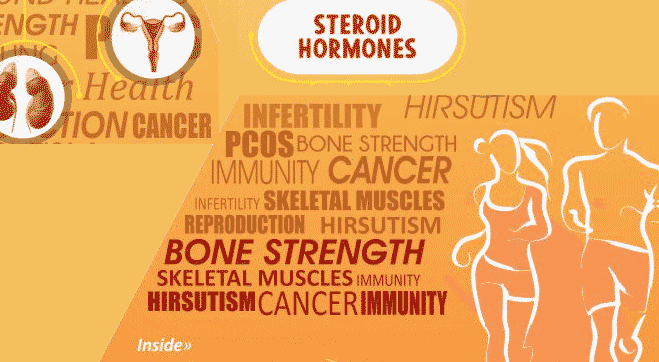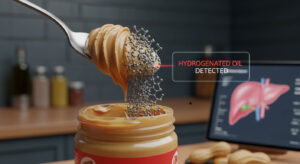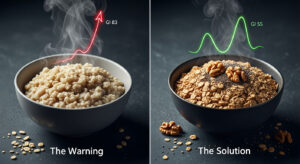What is the role of steroids in the body?
Steroid belong to the lipid family which includes cholesterol, steroid hormones and bile salts. They are predominantly found in the eukaryotic cells, where cholesterol is the most abundant steroid. This molecule is very well known as its extracellular levels in blood are directly related with the speed of development of atherosclerosis and consequently of coronary heart diseases.
Steroids are complex biomolecules that travel as messengers in the blood circulation. They occur in two forms: the ‘active form’ which moves freely into the blood circulation and the ‘dormant form’ which is attached to protein structures called plasma steroid binding protein. They exert their effect by interacting with the receptors present on the nucleus of the cell. This interaction leads to increase in protein synthesis which in turn leads to growth.
Cholesterol is the fundamental building block for all other steroids in the body. It is also the precursor of other important steroid metabolites including bile salts and steroid hormones.
Steroids produced in body can be broadly classified as corticosteroids & Anabolic Androgenic Steroids (AAS). Corticosteroids include the steroid hormones that are produced in the adrenal cortex and consist of glucocorticoids and mineralo-corticoids. AAS are chemically related to testosterone and they exert both androgenic effects (which confer masculine features like deepening voice, body hair, etc., and have effects similar to those of testosterone) and anabolic effects (which drives metabolism).
These broad groups can be further subdivided in five classes:
Mineralocorticoids Synthesized in the adrenal cortex, these hormones regulate the ion balance by promoting the reabsorption of certain inorganic ions like Na and Cl in the kidney. Thus, they help in maintaining blood pressure. One of the classic examples of mineralocorticoids is aldosterone. Estimation of serum aldosterone levels help in the diagnosis of Addison’s disease (adrenal insufficiency) or hyperaldosteronism (which may cause high blood pressure and lead to low levels of blood potassium).
Glucocorticoids These are also synthesized in the adrenal cortex and are so named because of their effects on glucose metabolism. They are thus instrumental in providing immediate source of energy to the body during any stressful situation. Hence, they are also known as “Stress hormones”. The primary glucocorticoid in humans is cortisol.
Cortisol Cortisol is a steroid hormone belonging to the class of glucocorticoids and regulates a wide range of processes throughout the body. It is the most abundant and potent glucocorticoid in humans and fishes. This hormone is released in response to stress and inflammation. It promotes gluconeogenesis and glycogenolysis. The main outcome of its metabolic influence is an increase in the blood sugar level.
Corticosterone Corticosterone is the primary glucocorticoid in reptiles rodents and birds. It has mild mineralocorticoid action as well.
Deoxycortisol (11-deoxycortisol) It is the immediate precursor for cortisol. Estimation of its level in blood and urine are helpful in the diagnosis and identification of the subtype of Congenital Adrenal Hyperplasia (CAH).
Progestogens These hormones are associated with the female reproductive cycle and are essential for maintenance of pregnancy. The most essential among all progestogens is progesterone. Given below is a brief about 2 types of progestogens.
Progesterone Progesterone is a natural female hormone essential for pregnancy. Also known as the pregnancy hormone”, it helps the uterus prepare for and maintain a fertilized egg. Estimating its serum levels can help identify whether ovulation has taken place in the particular menstrual cycle. It may also be used for diagnosis of placental insufficiency or some testicular or ovarian tumours. It also helps in recognizing and managing some causes of infertility, and in determining the effect of replacement therapy in case of women who are receiving progesterone injections.
17-Hydroxyprogesterone (17-OHP) 17 OH Progesterone is a hormone which is produced at the time of synthesis of glucocorticoids and sex hormones. Its clinical utility lies in the diagnosis and subtyping of CAH.
Androgens The most important among all androgens is testosterone which is primarily a male sex steroid hormone and is responsible for the development of secondary sexua characteristics in males. It is responsible for the growth and development of the male reproductive system, i.e. the penis, testes, prostate, sperms and other essential features. To some extent, they even influence the female sex drive. Examples of androgens are listed below.
Testosterone Testosterone is the most potent male sex hormone. It is tested to determine the causes of infertility, loss of libido and osteoporosis in men, while in females it helps to diagnose the reasons for hirsutism.
Androstenedione Ideally, androstenedione can be described as a “ProHormone” because it exerts very little biological effect by itself. Rather, its effects are pronounced when it is converted to estrogen and testosterone in different parts of the body. It is produced by gonads (testes in males and ovaries in females) and adrenal gland in both. Hence, its estimation is done to evaluate the proper functioning of these organs, mainly the adrenal glands. Elevated levels are seen in adrenal tumors, ACTH producing tumors and adrenal hyperplasia.
Dehydroepiandrosterone (DHEA) Dehydroepiandrosterone (DHEA) is one of the most abundant hormones produced by the adrenal gland. It is a precursor hormone and gets converted to other sex hormones like estrogen and testosterone in the body through various intermediate biochemical pathways. The levels of DHEAS exhibit a peak at the age of around 20-24 years after which, its levels continuously keep declining at a rate of 2-3% every year. DHEA is responsible for mood elevation, improving sleep patterns, supporting immune functions, maintaining bone health, maintaining cognitive functions and providing a sense of well-being.
DHEA Sulphate (DHEA-S) A large amount of DHEA which is secreted by the adrenal gland is secreted as DHEA-S , which is an androgen. Despite the fact that both are bound to albumin, binding of DHEA-S to albumin is much stronger. It is an indicator of adrenal androgen production. By itself, it is a weak androgen but it can get converted into potentially powerful androgens such as testosterone and estrogen. Its measurement is done to diagnose adrenal tumors and CAH.
Estrogens They are primary female sex hormones and are related to the development of female secondary sexual characteristics. Their values vary according to the age and timing of menstrual cycle being lower before puberty and after menopause. Also, the levels of estrogen determine the phase of the menstrual cycle. Estrogens play an important role in development of female secondary sexual characteristics and reproduction. They have also been found to influence the lipid metabolism, enzyme production, water and salt balance, bone density and strength, memory, sexual behaviour, etc. Estrogens are of four types: estradiol, estriol, estrone and estetrol. Here, we shall be restricting ourselves to the study of estradiol and estriol only.
Estradiol Estradiol is the most potent and found in highest concentration in premenopausal and non pregnant females. It belongs to the class of estrogens and is a female sex hormone produced by the ovaries. In girls and in women, testing for estradiol is useful in the diagnosis of early-onset of puberty, menstrual abnormalities, functional evaluation of ovaries and to detect estrogen producing tumors.
Estriol (E3) E3 is the primary estrogen found during pregnancy. It starts to rise in the 3 week and continues to rise throughout pregnancy. It is produced by the placenta (tissue that links fetus to the mother) as well in large quantities at the time of pregnancy. It is a part of the triple marker screening test to be done during pregnancy.
Estrone It is a weak estrogen found in men and post menopausal female.
Estetrol It is a weak estrogen that can be detected during pregnancy.
Vitamin D (Fat soluble vitamin) Vitamin D is considered as a pro-hormone which acts on nuclear receptors to exert its functions. It has a structure similar to other steroid hormones, only difference being a break in the carbon-carbon bond in one of the cyclopentanoperhydrophenanthrene ring because of which it is considered to be a secosterol. It is of two major types-Vitamin D2 (also known as ergocalciferol) and Vitamin D3 (also known as cholecalciferol). Vitamin D2 is found in plants specifically in yeast while vitamin D3 in its natural form is found in animals. Its levels are measured to diagnose the causes of bone weakness, bone malformation, abnormal metabolism of calcium, problems with parathyroid gland functioning and also to help in determination of the effectivity of vitamin D supplementation when prescribed.
Types of Steroids and their synthesis
Having introduced few of the basic terminologies and concepts required for understanding steroids, let us try to understand the two broad groups in which they are classified: the corticosteroids and the Anabolic Androgenic Steroids. In this article, we briefly outline the corticosteroids and AAS, their types, medical uses, the disorders and symptoms related to either excess or deficiency. Also, we introduce a third type of steroid, called as vitamin D, which is naturally synthesized in the human body. The given flow-chart explains the pathway by which production of various steroids takes place.
Corticosteroids Secreted by the adrenal cortex, corticosteroids are substances that are naturally produced by the body. The corticosteroids include two types of steroid hormones; the glucocorticoids and mineralocorticoids.
Types of Corticosteroids
Glucocorticoids They are steroid hormones which are produced by the adrenal cortex and their release is triggered by the hypothalamus and the pituitary gland. They have very powerful metabolic and anti-inflammatory effects on the body. Cortisol also known as cortisone and hydrocortisone, is the most important and the most potent of all glucocorticoids. It regulates body’s metabolism of fats, proteins and carbohydrates to release, energy. Another important glucocorticoid of the human body, refers to corticosterone. It works in association with cortisolto regulate immune responses and suppress inflammatory actions. Apart from the naturally occurring glucocorticoids, there are glucocorticoid drugs which have anti-inflammatory effects very similar to the naturally occurring ones. Thus, glucocorticoids are accountable for two major types of Adrenal Gland activities; anti-inflammatory and metabolic.
Mode of Action Metabolic effects of Glucocorticoids As the name suggests, these steroid hormones exert regulatory effects on glucose metabolism in the body. This implies that during periods of starvation or absence of food, the glucocorticoids stimulate certain processes that lead to release of glucose and thus maintain normal blood glucose concentrations.
Anti-inflammatory effects They exert their anti-inflammatory effects by binding to Glucocorticoid Receptor (GR) inside the cell and forming a complex which then enters the cell nucleus. These complexes lead to decrease in production of proinflammatory proteins and increase in production of anti-inflammatory proteins. Glucocorticoids can thus suppress the production of proteins like prostaglandins and interleukins which cause inflammation.
Medical Significance of Glucocorticoids Glucocorticoids mainly have anti-inflammatory and immunosuppressive effects in natural immune responses. Thus, they are used in treatment of inflammatory disorders such as rheumatoid arthritis (RA), Chronic Obstructive Pulmonary Disease (COPD) and asthma.
Also, they play an important role in metabolism by mobilizing the substrates for gluconeogenesis (generation of glucose from a new source) in cases of starvation and thereby maintain normal blood glucose levels.
They are also best known for the role they play in stress relief. They produce an array of effects to provide energy required for combating physical and emotional stress which may include fever, injury, illness and safety threats among others.
They are responsible for maintaining the body’s circadian sleep-wake cycle and also affect the food intake during this cycle. They are associated with resetting the body’s biological clock (a process that takes place very slowly) in instances of long travel which explains the reasons for jet lag.
Cortisol
It is principally secreted by the adrenal glands and is potentially a strong anti-inflammatory agent used for the treatment of RA
Medical Significance of Cortisol
- Helps in combating stress
- Brings about conversion to glucose from proteins
- Helps in reduction of inflammation
- Helps in maintaining constant blood pressure
Symptoms of increased and decreased levels of cortisol in the body Excessive cortisol in the body can lead to Cushing’s Syndrome. Symptoms include
- Increase in weight, especially in the upper torso, face and neck regions (Buffalo hump, Moon face, Central obesity)
- Appearance of purple stretch marks, loss of hair or easy bruisability
- Psychological problems such as depression, cognitive dysfunction and emotional liability
- High blood pressure
- Steroid induced osteoporosis
Lower cortisol levels can occur due to hypoadrenalism, the symptoms of which are as mentioned below
- Depression
- Heart palpitations
- Muscle weakness
- Extreme craving for salty foods
- Motion sickness
- Hypoglycemia
Diagnosis High levels of ACTH from pituitary gland stimulates adrenal gland to secrete cortisol. These elevated levels of cortisol are seen in cases of adrenal tumor, adrenal hyperplasia, paraneoplastic tumor, diabetes mellitus, acute stress, pregnancy, depression, hypoglycemia
Corticosterone It is a weak glucocorticoid and mineralocorticoid produced by the adrenal cortex and is used for the purpose of protein degradation and for synthesis of carbohydrates.
Medical Significance
- It aids in the conversion of amino acids int carbohydrates as a suitable fuel (glycogen) required in case of any biological reactions
- Is the precursor for aldosterone
- Major indicator of stress
- Plays a role in sleep-wake patterns
- Has effects on long term memory, memory recognition and consolidation
Symptoms of higher and lower levels of corticosterone in the body
- Elevated levels of corticosterone in the body produce symptoms similar but milder to those of Cushing’s disease in addition to a few more like
- Stress
- Impairment of long term memory retrieval
- Reduction in potassium levels with increased sodium levels
Deoxycortisol 11-Deoxycortisol is used for diagnosing and monitoring of CAH. It is an intermediate in the formation of cortisol.
Medical Significance
Aids in the diagnosis of patients with CAH
Aids in testing for adrenal insufficiency (condition in which the adrenal gland do not produce enough
amount of steroid hormones, especially cortisol)
Symptoms of higher and lower levels of deoxycortisol in the body
Deficiency of deoxycortisol usually accompanies symptoms such as virilization, hypertension and salt
wasting (a rare condition in which sodium levels are decreased with a corresponding increase in
potassium levels) which are seen in CAH due to 11-B hydroxylase deficiency. Markedly high levels
of deoxycortisol result in severe acne.
Mineralocorticoids
Mineralocorticoids are involved in the regulation of minerals, such as sodium, potassium and hydrogen
ions which aids in maintaining the water balance in the body. Their targets of action are generally the
salivary glands, kidney and colon. Mineralocorticoids function by retaining sodium and flushing out
potassium and hydrogen in the urine. Retention of sodium leads to water retention, thus causing an
increase in blood pressure. This increase is sensed in the kidney which regulates release of mineralocorticoid
so that the delicate salt, water and sodium balance is not disrupted. Mineralocorticoids are also associated
with increase in excretion of calcium and magnesium.
Mode of Action
Aldosterone is the principal mineralocorticoid in the human body. It activates the mineralocorticoid receptors
in the distal tubule of the kidneys to modulate sodium levels. Aldosterone also leads to increased activity of
NaKATPase in the serosal membrane.
Medical Significance of Mineralocorticoids
Increased resorption of sodium ions in the kidneys
Increased resorption of water to maintain the osmotic balance
Increased excretion of potassium from the kidneys
Affects sweat glands, salivary glands and the colon to conserve sodium
which in turn leads to conservation of water
Symptoms of higher and lower levels of Aldosterone in the body
- Excessive aldosterone in the body can lead to primary hyperaldosteronism (Conn’s Syndrome). This may be caused due to an aldosterone producing adrenal tumor. The most common symptoms for the onset of this disease include:
- High blood pressure
- Fatigue
- Muscle cramps and muscle weakness
- Numbness
- Excessive aldosterone may also occur due to secondary hyperaldosteronism or reasons other than disorder in the adrenal gland and is more common than primary hyperaldosteronism. It leads to cases of congestive heart failure, cirrhosis of the liver, toxemia of pregnancy and kidney disease.
Lower aldosterone levels lead to hypoaldosteronism, the symptoms of which include low blood pressure, palpitations, lightheadedness, salt craving, dizziness, etc.
Diagnosis
Elevated levels of aldosterone can be seen under conditions such as Conn’s Syndrome, secondary
hyperaldosteronism, Batter Syndrome and consumption of a very low sodium diet. Lower levels may
be indicative of Addison’s Disease and a very high sodium diet.
Normal levels of aldosterone are 2.21-35.3 ng/dL in upright position while 1.17-23.6 ng/dL in supine position.
Anabolic Androgenic Steroids (AAS)
Anabolic Androgenic Steroids is structurally similar to testosterone and has been placed under the Anabolic Steroids Control Act of 1990 in Schedule III of the Controlled Substances Act (CSA). These are synthetic derivatives of the male sex hormone, testosterone. They are so called because they have two types of effects on the body, anabolic and androgenic. Anabolic because they improve the muscle mass, while androgenic because they confer masculine characteristics. They exert very strong physiological effects on the body and are useful in improving physique and performance of athletes. Administration of external Anabolic Androgenic Steroids incurs two major beneficial effects to the athletesgain of strength (of about 5-20% of the initial strength) and increase in the body weight. Although people may be legally prescribed steroids to treat certain conditions associated with hormonal deficiency such as delayed onset of puberty, or diseases that result in loss of lean muscle mass such as AIDS or cancer, some athletes and bodybuilders abuse steroids to enhance their performance and body physique.
Types of Anabolic Androgenic Steroids
The two major types of AAS include endogenous steroids and exogenous steroids. As the name suggests,
exogenous steroids are produced outside the body and cannot be produced naturally. Examples of
exogenous steroids include nandrolone and danazol. Contrary to this, endogenous steroids are
synthesized by the body itself. These comprise of the naturally occurring substances that are involved
in the testosterone metabolic pathway. Examples of endogenous steroids include estrogens (estradiol)
and testosterone.
Endogenous Steroids
The steroids that are produced naturally in the body are called as endogenous steroids.
Estradiol
It is a female sex hormone that is very much essential during the reproductive years and is produced by the ovaries, adrenal gland and the placenta during pregnancy. It belongs to the class of estrogens. Estrogen has four forms: estradiol, estriol, estrone and estetrol. In females, estradiol primarily acts like a growth hormone for the reproductive organs which consist of the vagina, fallopian tube, endometrium and the cervical glands Additionally, it also promotes the growth of myometrium of the womb, maintains the oocytes and promotes the ovulation process. The secondary sexual characters in a female that are affected by estradiol include normal breast development, skin changes, etc.
Mode of Action of Estradiol
Like other steroids, estradiol is also a nuclear hormone, meaning that it interacts with receptors present
inside the cell to trigger a metabolic pathway to carry out its ultimate function.
Medical Significance
- Growth and maintenance of female reproductive system and the breasts
- Influences the growth of uterine lining in the first part of menstrual cycle
- Responsible for fluid retention
- Affects protein breakdown in the body
- Responsible for prevention of ovulation and breast engorgement in females after child birth
- Influences levels of calcium in the body by the virtue of which they are involved in the shaping of the skeletal structure
Symptoms of higher and lower levels of estradiol in the body
The symptoms of high estradiol levels include bloating and weight gain, decreased sex drive,
irregular periods, atherosclerosis and leg cramps while in case of low estradiol levels, symptoms
such as irregular menses, loss of libido, hot flashes, fatigue and osteoporosis appear.
Diagnosis
Estradiol is necessary for the growth of the female uterus, fallopian tubes and vagina.
Elevated levels of the same can be seen in cases of ovarian tumor, early puberty,
gynecomastia and pregnancy while decreased levels may be indicative of Turner’s
Syndrome, menopause, infection such as mumps, toxicity (due to radiation, chemotherapy)
and trauma. Other conditions under which this test may be performed include hypopituitarism
and in infertility patients under Assisted Reproductive Technology (ART).
This test may be performed if male or female sexual characteristics do not develop at the normal rate.
Estriol (E3)
It is a form of estrogen which is weaker than estradiol and is produced in most measurable amounts at
the time of pregnancy. However, it is present throughout the life span of a woman and its levels keep
fluctuating throughout the day.
Medical Significance
It can help in reducing few of the symptoms which are associated with perimenopause
(around the time of stopping of menses) and menopause such as hot flashes, vaginal
dryness and low bone density
Beneficial for a healthy heart
Confers protection against osteoporosis
Symptoms of higher and lower levels of estriol in the body
Lower levels of E3 during the second trimester of pregnancy acts as a marker for Down Syndrome
and Trisomy 18. They are also associated with loss of pregnancy.
Higher levels of E3 indicate impending labor. The rise in the levels of E3 occurs approximately 4 weeks prior to labor pain.
Diagnosis
Estriol is the biologically active form of estrogen and is made in large quantities during pregnancy.
Its levels increase three fold during the final trimester of pregnancy. If the levels fall below normal,
it could indicate the following problems for the fetus
Trisomy 21 (Down Syndrome)
Trisomy 18 (Edwards Syndrome)
Fetal anencephaly
Sulphatase deficiency
Fetal death
Progesterone
It is an endogenous steroid hormone released by the ovary and belongs to the class of progestogens. It has significant roles to play in the menstrual cycle and also helps to maintain early stages of pregnancy.
Mode of Action of Progesterone
Like all other steroid hormones, progesterone is also hydrophobic in nature and thus can diffuse
through the cell membrane. In endometrial cells, it binds to the cytoplasmic receptor termed as
progesterone receptor. The complex then moves into the nucleus where it binds to Progesterone
Response Element (PRE) and causes modification in the genes to cause changes in protein synthesis
and thereby exerts its effects.
Medical Significance
- Its major function is to prepare the uterine lining in order to make it mature enough to accept a fertilized ovum
- Progesterone protects the embryo from being rejected (by decreasing maternal immune response) and is responsible for maintaining the pregnancy throughout the nine months
- It has a protective function against various kinds of cancers like uterine cancer, breast cancer, colon cancer and rectum cancer
- Drop in its level causes menstruation cycles. So, in a way, it prevents menstruation
- It causes inhibition of lactation during pregnancy
Symptoms of higher and lower levels of progesterone in the body
There are quite a few symptoms indicating high levels of progesterone in the body. These include
- Mood swings
- Anxiety
- Bloating
- Weight gain
- Hot Flashes
Lower levels of progesterone are indicated by
- Depression
- Mood Swings
- Breast tenderness
- Gum disease
- Loss of libido
- Gallbladder disease
- Increases risk of endometrial cancer
Diagnosis
Elevated levels of progesterone may be observed in cases of pregnancy, adrenal tumors,
ovarian cancers and CAH, while lower levels may be due to amenorrhea, ectopic pregnancy,
fetal death and possible miscarriage. Normal levels of progesterone are described below
17-a-OH Progesterone
This hormone is the most essential for the building up of cortisol. 17-OHP is produced by the adrenal glands in the adrenal cortex and also in the gonads. It is a precursor of cortisol. Its concentration increases during pregnancy in both the mother and the fetus.
Medical Significance
It is used to detect CAH in newborns
It also helps to detect the causes of ambiguous genitalia
Symptoms of higher and lower levels of 17-OHP in the body
Elevated levels of 17-OHP are indicative of CAH whose symptoms are indicated below
- Dehydration
- Low blood pressure
- Not eating well
- Lethargy
- Acne
Diagnosis
This test is done for the detection of CAH, adrenal tumors and late onset of adrenal hyperplasia.
Elevated levels of 17-OHP indicate the presence of CAH in older children. It is routinely ordered
as a part of newborn screening test. This test may also be ordered when a girl or a woman is
suspected of having Polycystic Ovary Syndrome (PCOS).
Symptoms of PCOS include
- Hirsutism
- Lack of regular menses
- Development of male secondary sexual characteristics
- Infertility
Testosterone
Though primarily recognized as a male sex hormone, testosterone is also found to be present in females, although to a much lesser extent (females produce less amount of testosterone daily as compared to males who produce 5-6 mg of the hormone every single day).” It is an AAS produced by the testicles in men and by ovaries in women. Its anabolic effects include growth and maintenance of muscle and bone tissue, increase in protein synthesis leading to increase in musculoskeletal mass, enhancement of glycogen synthesis and increasing reabsorption of sodium in the kidneys. Dihydrotestosterone, a derivative of testosterone plays a major role in the development of primary sexual characteristics such as development of the male reproductive system and organs including the testes and prostate and regulation of the sex drive (libido). It is also required for the development of secondary sexual characteristics like facial hair, armpit, chest and pubic hair in men, and deepening of voice.
Mode of Action of Testosterone
There are two primary mechanisms by which this hormone exerts its effects
Testosterone can lead to the activation of the androgenic receptor on its own or after
reduction to 5-a dihydrotestosterone (DHT) by the enzyme 5-a reductase.
It can also be converted into estradiol with the help of the enzyme aromatase, which is one of the
most important estrogens involved in the female reproductive system function.
Medical Significance
- Involved in the growth and development of the male sex organs including the penis and testis
- Influences development of male secondary sexual characteristics like growth of pubic, facial and body hair
- Increase in the sexual drive or libido
- Maintains bone density and increases muscle protein thereby leading to increase in muscle strength
- It also controls fat distribution by regulating distribution of adipose tissue in the body
Symptoms of higher and lower levels of testosterone in the body
Higher levels of endogenous testosterone can cause precocious puberty, very fast growth rate in
adolescents, high libido, acne and excessive hair.
In females higher levels of endogenous testosterone may cause hirsutism, i.e., excessive hair on the face and chest. Other common symptoms include virilization, deepening of voice, male pattern baldness and acne.
Lower levels of testosterone can be either due to primary hypogonadism or secondary hypogonadism. The former indicates problem originating from the testicles whereas the later shows any problem in the hypothalamus or the pituitary gland (glands that stimulate the synthesis of testosterone).
Lower levels of endogenous testosterone in males causes loss of libido, erectile dysfunction, enlarged breast, unexplained bone fracture, loss of body hair and fatigue.
Lower levels of testosterone in females cause low libido, hot flashes, irregular periods, painful sexual intercourse and anorgasmia.
Diagnosis
Testosterone being the most dominant male hormone, any problems related to its secretion
can be a cause of concern in the development of male sexual characteristics which may lead to sexual dysfunction. Deficiency of testosterone may be caused due
to any disease or damage caused to the hypothalamus, pituitary gland or testicles. While in general, the
reasons of excess testosterone are rare, it may be sometimes caused due to testosterone replacement therapy.
DHEA and DHEA-S
DHEA is a natural steroid hormone and in the body and is produced by the adrenal glands. DHEA is a powerful precursor for all of the major sex hormones: estrogen, progesterone, and testosterone. Natural DHEA production is at its highest peak in a person who is in his twenties. It is responsible for mood elevation, improving sleep patterns, supporting immune functions, maintaining bone health, cognitive function and providing a sense of well-being.
DHEA-S is the sulfated analog of DHEA. It serves to be a precursor molecule for the production of DHEA and is circulated to peripheral tissues in conjugation with albumin. In the adrenal glands and in the peripheral tissues, DHEA-S is enzymatically desulfated to produce DHEA which in turn serves to be a precursor for the production of sex hormones: estrogen and testosterone.
DHEA and DHEA-S can be interconverted with the help of the enzyme sulfhydrylases, in the peripheral tissues and adrenal gland.
Medical Significance
DHEA and DHEA-S act as precursors for approximately 50% of androgens in men, 75% of active
estrogens in premenopausal women, and 100% of active estrogens after menopause.
Evidenced data suggest that there is an inverse relationship between the levels of serum DHEA
and DHEA-S and the occurrence of diseases like cancer, cardiovascular disease, Alzheimer’s disease
and other age related disorders.
It also plays a role in treatment of Systemic Lupus Erythematosus (SLE), for improving bone density
in postmenopausal women, and treatment for symptoms of severe depression.
DHEA-S levels help in the diagnosis of adrenocortical tumors, adrenal cancers and CAH.
They enhance the immune response and provide a sense of well-being
Symptoms of higher and lower levels of DHEA and DHEA-S in the body
Excessive levels of DHEA result in acne, increased facial sebum and mild hirsutism in females.
Women having levels of endogenous DHEA-S in the highest quartile have a significantly higher
risk of developing breast cancer as compared to women in the lowest quartile.
Lower levels of DHEA and DHEA-S cause chronic fatigue, hypoglycemia, low blood pressure and dizziness.
Diagnosis
Lower levels of DHEA has been attributed to cause multiple clinical conditions like diabetes, impaired
cognitive function, reduced immunity, ageing, increased risk of cardiovascular diseases in men and
increased risk of premenopausal breast and ovarian cancer in women. Though higher levels of this
naturally occurring hormone have no documented effects on men, in women it may result in irregular
heart beats or arrhythmias, thinning of hair, deep voice, hirsutism, etc. Levels in women are also elevated
during conditions like PCOS and cancer of the adrenal gland.
Androstenedione
It is a natural endogenous androgenic steroid. Its production takes place in the adrenals, ovaries and testicles. DHEA is converted to androstenedione which is then transformed into testosterone and also into estrogen.
Medical Significance
Increases estrogen levels
Thought to increase testosterone levels and thereby increase muscle mass.
However, these effects have not yet been proven
Symptoms of higher and lower levels of androstenedione in the body
Excessive levels of androstenedione in men may result in gynecomastia and also reduction in
the size and volume of testes. The same condition in women may lead to hirsutism, amenorrhea, excessive
acne and changes in the external genitalia.
Lower levels of androstenedione in men can result in diminished development of sexual characteristics such as pubic and body hair, voice deepening and growth of the sexual organs. In a similar fashion, too little of androstenedione in girls may cause failure to start periods and no visible changes caused during the onset of puberty.
Diagnosis
Androstenedione is an immediate precursor to both testosterone and estrone, both of which are
subsequently converted to estradiol. Its levels are elevated due to virilization in women, CAH,
PCOS and in some unknown causes of hirsutism in women. In men, higher levels of androstenedione
may lead to changes such as breast development, testes becoming smaller, while lower levels may
be indicative of failure in the development of sexual characteristics associated with puberty like
deepening of voice, development of pubic and facial hair, etc. Similar is the case of females having too
little of androstenedione, as they may fail to start their periods and may not undergo many of the changes
that occur during the onset of puberty.
Vitamin D
Introduction to vitamin D
Historically, vitamins got their name as they were considered to
be vital amines that are required by the body in small quantities, but cannot be synthesized by the body.
Hence, they should be acquired from diet. Vitamins can be broadly classified as fat soluble
(Vitamins A, D, E and K) and water soluble (Vitamin B complex and C). However, technically speaking,
vitamin D is classified as a secosteroid (steroid with a broken ring structure). In this section, we will
discuss about vitamin Das it is also classified as a steroid hormon Vitamin D is of two major types-vitamin
D2 (also known as ergocalciferol) and vitamin D3 (also known as cholecalciferol). Vitamin D2 is found in plants specifically in yeast while vitamin D3 in its natural form is found in animals. The molecular structure
of vitamin D is closely related to that of the well known steroid hormones like cortisol, estradiol,
progesterone, aldosterone and testosterone.
As previously stated, cholesterol is very abundantly present in the human cells and acts as a precursor for the synthesis of vitamin D3 in human bodies. Cholesterol gets converted into 7-dehydrocholesterol in the skin on exposure to early morning sunrays, specifically ultraviolet B (UVB) rays. The 7-dehydrocholesterol undergoes photochemical conversion in the skin to form vitamin D3 (cholecalciferol).
This vitamin D3 is a precursor for the production of 25hydroxy vitamin D which takes place in the liver. 25hydroxy vitamin D then acts as a substrate for the enzyme 1-alpha-hydroxylase in the kidneys to yield 1,25-dihydroxy vitamin D3, which is the biologically active form of the vitamin. 1,25-dihydroxy vitamin D3 is considered to be a steroid hormone because the mechanism by which it produces the biological responses that are attributable to vitamin D resembles that of steroid hormones.
Sources of Vitamin D
Exposure to early morning sunlight (UVB rays to be specific) is the best source to allow the synthesis
of vitamin D3 in the body. Other natural sources of vitamin D3 are fishes like tuna, cod (cod liver oil in specific)
as well as egg yolk. Except for these natural sources, these days there are a lot of food items like milk, juices,
cereals, etc. which are fortified with this vitamin.
Medical Significance
One of the most important functions that vitamin D serves in the human body is that of regulation of
calcium metabolism by stimulating calcium absorption from food across the intestine. It is important
for maintenance of good bone health and for prevention of diseases such as rickets or osteomalacia.
It also plays an important role in activation of the innate and adaptive immune system, facilitates
insulin secretion, improves muscle strength and regulates heart muscle function and blood pressure.
It is also thought to be involved in the development of brain and having anti-cancer effects.
Symptoms
Vitamin D deficiency can lead to
- Fatigue
- Muscle cramps
- Joint pain
- Poor concentration
- Bladder problems
- High blood pressure
- Weight gain
- Rickets
- Osteomalacia
- Depression
- Dental caries
- Cystic fibrosis
- Multiple sclerosis
- Gout
- Parkinson’s disease
- Depression
- Alzheimer’s disease
- Chronic pain
- Psoriasis
Vitamin D Toxicity
This is rare but may occur due to excessive supplements. The condition is also known as hypervitaminosis.
Symptoms of Vitamin D toxicity include
- Fatigue
- Weight loss
- Loss of appetite
- Excessive thirst and urination
- Tinnitus (Ringing in the ear)
Hypervitaminosis may lead to
- Excessive levels of calcium in the blood affecting bones, tissues and other organs
- Kidney damage due to formation of stones
- Excessive bone loss
- Calcification in the soft tissues
Diagnosis
Amount of vitamin D present in the body is determined by estimating the levels of total
vitamin D (including D2 and D3). However, vitamin D3 is the more abundant form present
in the human body as it is the one synthesized by the skin. The information we can acquire
from estimation of vitamin D includes
Accurate diagnosis and identification of suspects of rickets and osteomalacia, and better
management of the same.
An early indicator for osteoporosis
Signals the population at risk (who do not get or get very little of exposure to sunlight)
Normal levels range between 30-100 ng/mL.
Lower levels indicate inflammatory bowel disease (eg. Crohn’s Disease), short bowel syndrome, nephrotic syndrome, biliary cirrhosis, liver dysfunction or necrotic syndrome. Higher levels indicate hypocalcemia and vitamin D intoxication.
This test is done using LC-MS/MS technology.
Exogenous Steroids
The exogenous steroids may chemically mimic the actions of testosterone in the body. They can
exert strong physiological effects on the human body and thus prove to be beneficial to the athletes.
They enhance the muscle strength and mass simultaneously bringing about a decrease in the body fat.
These kinds of steroids are widely consumed by athletes all over the globe such as those who are into
weight lifting, playing football, etc. for boosting up their strength, power, aggressiveness and endurance
during the performance.
Mode of Action
They work on a similar principle as that of testosterone. These steroids additionally may exert anti-catabolic
effects which means that they would prevent muscle breakdown even when followed by an intense workout.
This effect might be due to blocking of the effects of hormones such as cortisol which are involved in tissue
breakdown during and after exercise. It may also cause reduced testosterone secretion.
Medical Significance
Short term effects of administration of these exogenous AAS in patients suffering from muscle-wasting
syndrome has been shown to have a beneficial effect on increasing lean body mass in a greater proportion
as compared to nutritional intervention alone.
Anabolic Androgenic Steroids such as oxymetholone can be used for the treatment of a variety of hematologic disorders such as sickle cell anemia, hairy cell leukemia, etc. This beneficial effect can be attributed to erythropoietic and myelopoietic effects of oxymetholone.
Advantages
- Increased rate of protein synthesis thereby leading to an increase in the body’s ability to build and repair muscle tissues.
- Increased nitrogen retention which even helps in retaining the hard earned muscle tissue.
- Also helps in prevention of muscle catabolism.
- Increase in endurance is achieved by increasing the production of RBCs.
- Increased fat loss as they allow the body to utilize carbohydrate more efficiently as an energy source.
- Lead to a feeling of well being and higher tolerance to stress.
Disadvantages
- Leads to increase in blood pressure due to higher rate of erythropoiesis
- Increase in cholesterol levels
- Enlargement of the prostate gland is observed
- Testicular atrophy
- liver damage which is most often associated with oral steroids which are 17 alpha-alkylated
- Virilization in women implies the development of masculine characteristics in females. The effects include enlargement of the clitoris, increase in the growth of body hair, deepening of the voice and a tremendous increase in the body libido
Change in behaviour leading to aggression
Sterility- continuous use of steroids can lead to impotency in both men and women alike
Thinning of hair and severe acne are also a result of steroid abuse
Symptoms
- Impaired spermatogenesis
- Impotency
- Hirsutism in females
- Menstrual irregularities
- Reduced breast size
- High blood pressure
- Thrombosis
- Arrhythmias
- Acne
- Mood Swings
Anabolic Androgenic Steroids abuse
AAS use has been widespread, especially in athletes to endure their performances and to augment
their muscular development and strength. This is taken by athletes and weight lifters to increase
their muscle mass and strength. There is a wide range of possible adverse effects that can be caused
due to the abuse of AAS. Some of these effects are enlisted below
- Hypertension
- Depressive symptoms
- Mood swings
- Decreased libido
- Kidney stones
- Impaired spermatogenesis
- Infertility
- Deepening of voice in women
Doping, a very familiar term in sports industry, implies the use of prohibited drugs by athletes to enhance their muscle strength and performance. A well known incidence of such doping includes that of Dieter Baumann, a German Olympics champion of 1992, who was tested positive for nandrolone, a type of steroid and was banned for two years. Recent among the doping cases include that of much publicized seven times Tour de France winner, Lance Armstrong. These are just few of the numerous cases of doping which have been reported by World Anti-Doping Agency (WADA) till date.
Thus, we conclude, stating that not all steroids are bad, but anything in excess (steroid abuse) is not right. It is not always the case which reiterates the more, the merrier.








